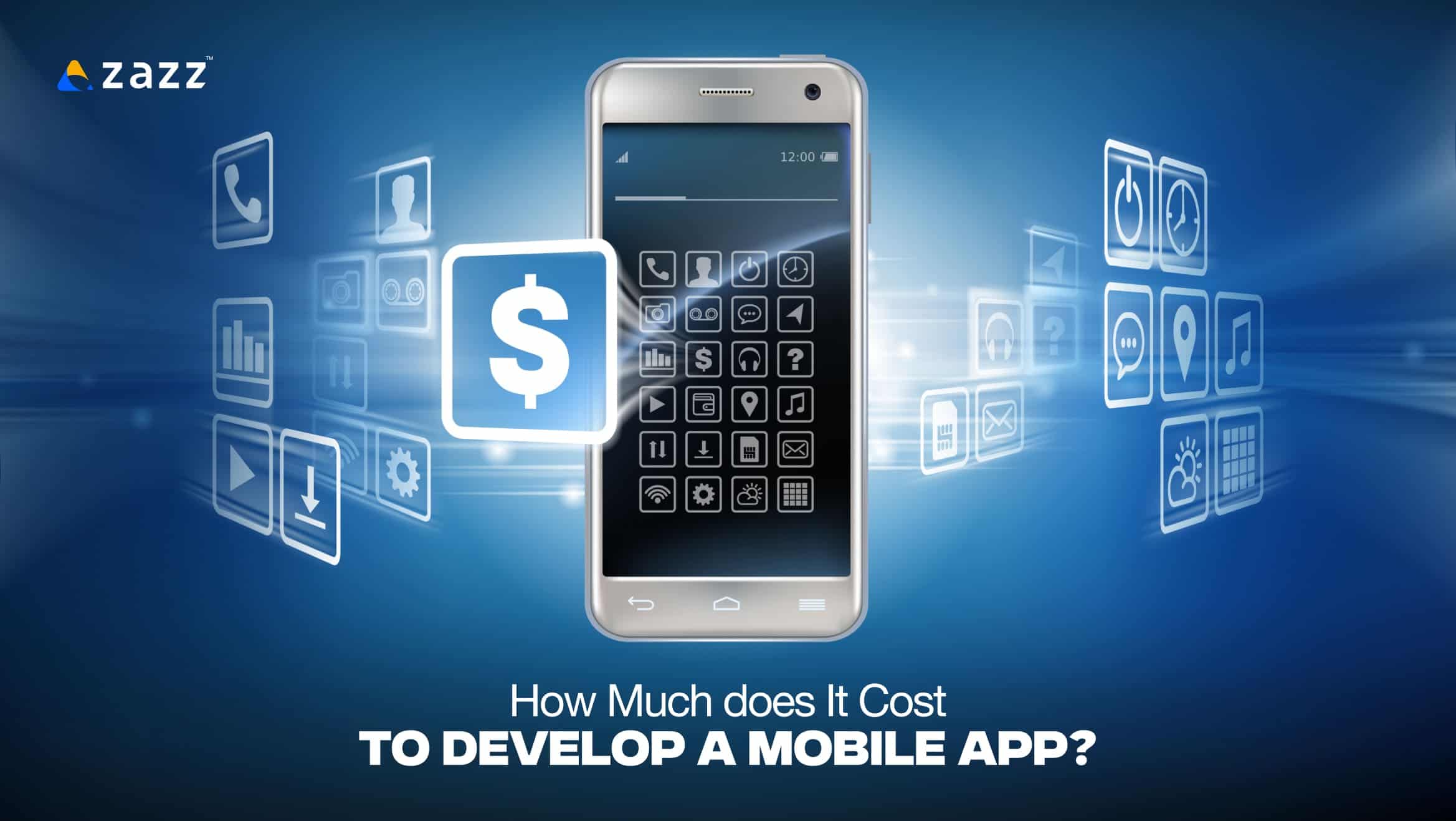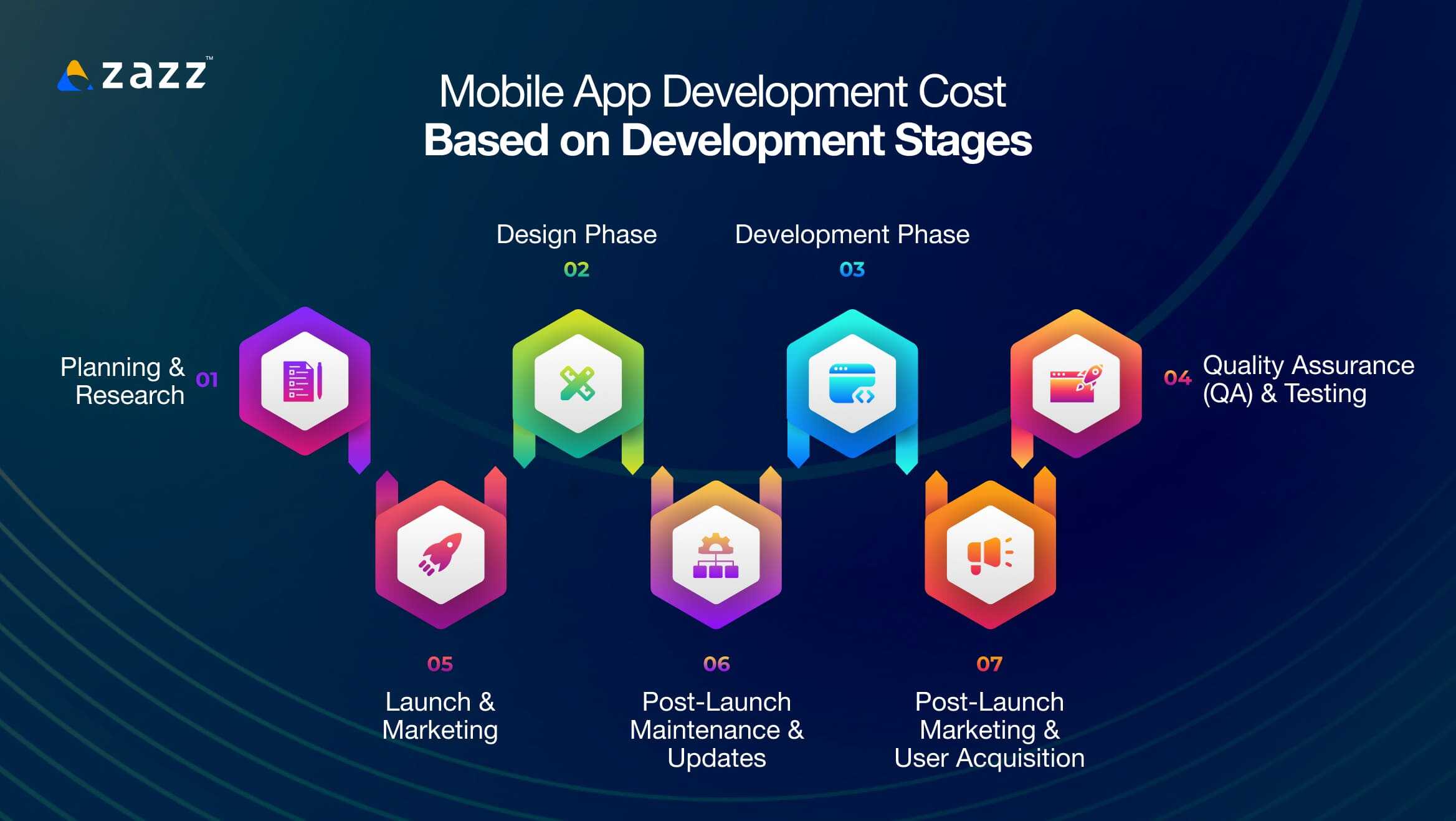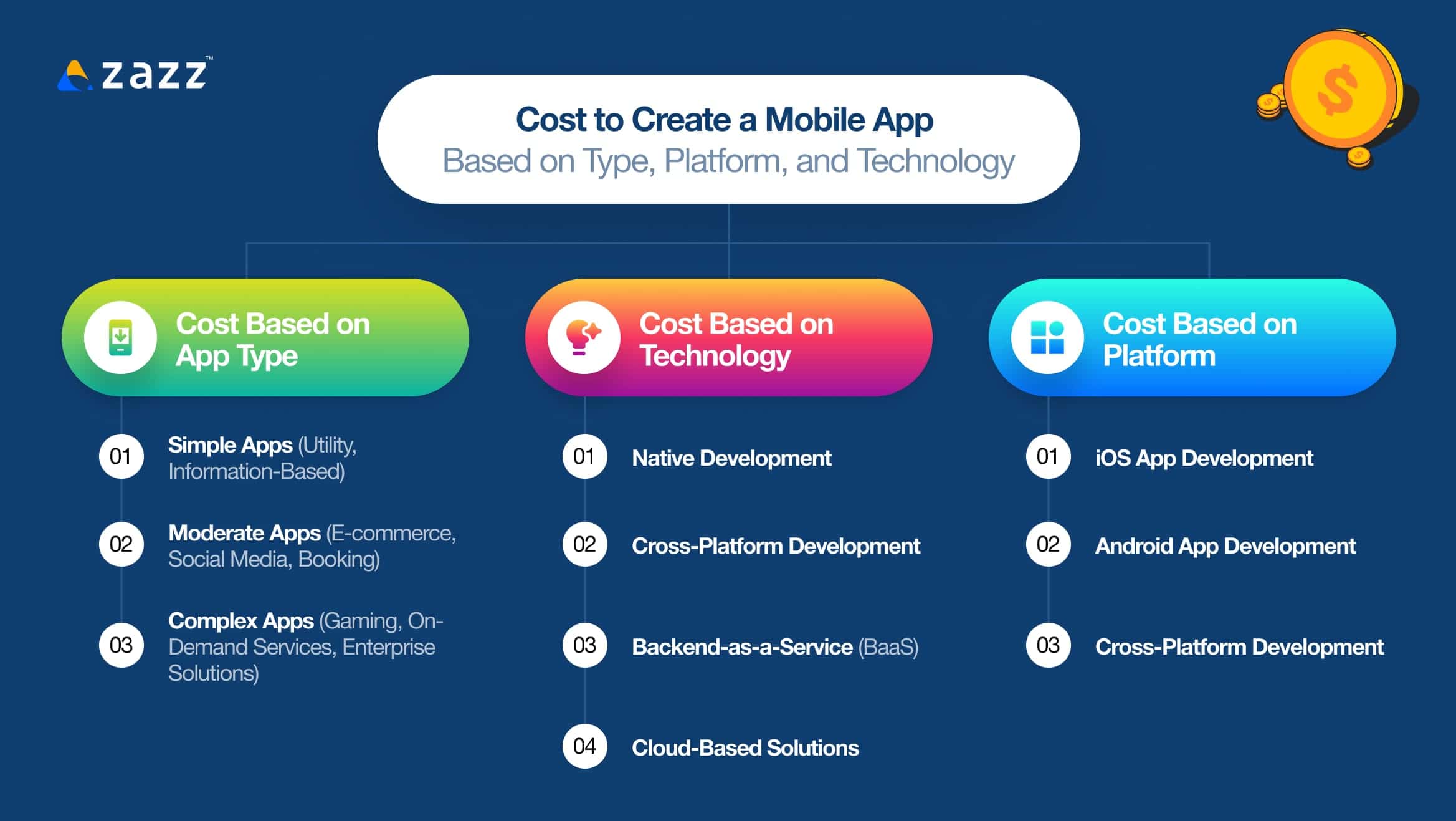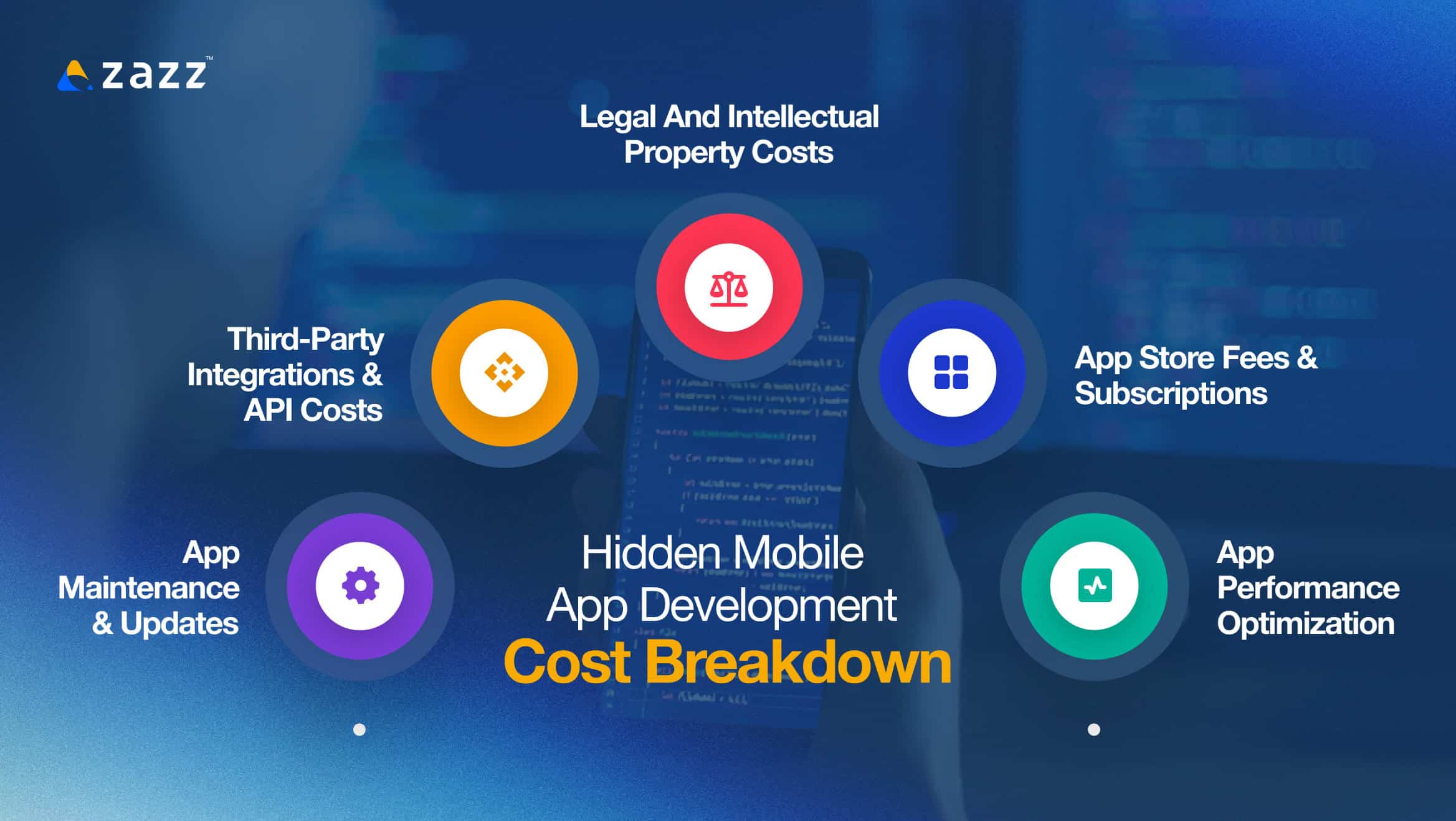
Table of Content 1. Mobile App development cost breakdown based on development stages
2. Cost to Create a Mobile App Based on Type, Platform, and Technology
3. Hidden mobile app development cost breakdown
4. How to reduce mobile app development costs?
5. What is your take home here?
As we approach 2025, the mobile app industry shows no signs of slowing down, with businesses across all sectors relying on apps to engage customers, streamline operations, and deliver innovative solutions. But for entrepreneurs and companies looking to bring an app idea to life, one major question looms: How much will it cost? The cost of app development has become increasingly complex, influenced by technological advancements, market demands, and the specific requirements of your project. From choosing the right platform to integrating cutting-edge features, understanding the factors that affect app development costs is crucial for making smart, cost-effective decisions. In this blog, we’ll explore the key drivers of app development costs in 2025, providing you with the insights needed to budget effectively and create an app that delivers value without breaking the bank.
Mobile App development cost breakdown based on development stages:

Cost to build an app in 2025 is influenced by various factors that come into play during different stages of the development process. From conceptualization to launch and post-launch maintenance, each phase incurs costs that can vary significantly based on the app’s complexity, features, and the team involved. Let’s break down the costs by development stage:
1. Planning & Research
- Cost Range: $5,000 – $15,000+
- Description: This initial phase is crucial for understanding the target audience, defining the app’s purpose, and gathering requirements. Costs here include market research, competitor analysis, user persona creation, and defining key features. Businesses may also opt for consultations with UX/UI experts to plan the design and user flow.
- Key Factors: The depth of market research, clarity of requirements, and involvement of experienced strategists.
2. Design Phase
- Cost Range: $10,000 – $50,000+
- Description: The design phase includes wireframing, UI/UX design, prototyping, and user testing. The user interface (UI) must be visually appealing, while the user experience (UX) should be intuitive. Depending on the complexity, custom design elements, animations, and interactive prototypes can increase costs.
- Key Factors: Number of screens, complexity of animations, and the use of custom-designed UI elements versus standard templates.
3. Development Phase
- Cost Range: $30,000 – $250,000+
- Description: This stage encompasses the actual coding and development of the app. It is typically the most expensive phase, as it involves back-end (the server-side logic, database management) and front-end development (what users see). The choice between developing for a single platform (iOS or Android) or both (cross-platform) significantly impacts costs.
- iOS-only development tends to be cheaper than developing for both platforms because it requires fewer resources.
- Cross-platform apps developed using tools like Flutter or React Native development can reduce costs but may require specialized development skills.
- Back-end complexity: Apps with complex features such as real-time data, user authentication, or heavy databases will drive up the back-end costs.
- Key Factors: Platform(s) chosen (iOS, Android, or both), app complexity (simple or feature-rich), integration with third-party APIs, and database architecture.
4. Quality Assurance (QA) & Testing
- Cost Range: $5,000 – $30,000+
- Description: Ensuring the app functions smoothly and is free from bugs is crucial. Testing is an ongoing process during the development stage but may intensify just before launch. QA testers evaluate usability, security, compatibility across devices, and performance under different conditions. Costs increase with the number of devices, operating systems, and specific use cases the app must support.
- Key Factors: The variety of devices and OS versions the app needs to support, the depth of testing required (manual vs. automated), and testing for specific security and compliance standards.
5. Launch & Marketing
- Cost Range: $5,000 – $50,000+
- Description: Once the app is ready, the next step is deploying it to the App Store or Google Play, and sometimes this phase also includes submitting it for review and approval. Additionally, marketing costs such as app store optimization (ASO), paid advertising, influencer collaborations, and PR efforts to generate buzz can increase launch expenses.
- Key Factors: App store submission fees, the scale of marketing campaigns, and promotional efforts needed to drive initial downloads.
6. Post-Launch Maintenance & Updates
- Cost Range: $5,000 – $30,000/year+
- Description: Once the app is live, ongoing maintenance is required to fix bugs, update features, improve security, and ensure compatibility with new OS versions. Updates are essential to keep the app relevant, meet user expectations, and adapt to changes in technology. The frequency and complexity of updates directly influence costs.
- Key Factors: Frequency of updates, the need for adding new features, server maintenance, and responding to user feedback.
7. Optional: Post-Launch Marketing & User Acquisition
- Cost Range: $10,000 – $100,000+
- Description: While launching an app is a milestone, maintaining and growing its user base is an ongoing challenge. If user acquisition is a priority, companies may invest in long-term marketing campaigns, influencer partnerships, social media engagement, content marketing, and paid user acquisition strategies (such as PPC or social media ads).
- Key Factors: Marketing channels used (organic vs. paid), scope of campaigns, and influencer or partnership costs.
Summary of Cost Breakdown by Stage:
- Planning & Research: $5,000 – $15,000+
- Design Phase: $10,000 – $50,000+
- Development Phase: $30,000 – $250,000+
- Testing & QA: $5,000 – $30,000+
- Launch & Marketing: $5,000 – $50,000+
- Maintenance & Updates: $5,000 – $30,000+/year
- Post-launch Marketing & User Acquisition: $10,000 – $100,000+
Each stage of app development plays a vital role in shaping the final product, and cost of developing an app vary significantly depending on the complexity and scope of your project. Understanding how each phase contributes to the overall budget allows you to make informed decisions, set realistic expectations, and avoid surprises as you progress from concept to launch and beyond. You can also use an app cost calculator to get a quick estimate based on your project requirements.
Related reading: 5G Revolution: Impact and Evolution in Mobile App Development
Cost to Create a Mobile App Based on Type, Platform, and Technology

When it comes to mobile app development cost estimate, the type, platform, and technology you choose will significantly influence the overall cost. Each decision affects development time, complexity, and the resources required, making it essential to understand how these factors contribute to the final cost to build an app. Let’s break down the costs based on these three aspects.
1. Cost Based on App Type
The type of mobile app you’re building plays a pivotal role in determining mobile app development price. Each app type has unique requirements that influence the amount of work, features, and technology involved.
a. Simple Apps (Utility, Information-Based)
- Cost Range: $5,000 – $25,000
- Description: These apps typically offer basic functionality such as calculators, to-do lists, or informational apps (news, weather, etc.). The design and development are simple, with minimal back-end requirements.
- Key Features: Single or few screens, basic UI, limited features, no heavy data processing, no third-party integrations.
b. Moderate Apps (E-commerce, Social Media, Booking)
- Cost Range: $25,000 – $100,000
- Description: These apps are more feature-rich and complex, involving user registration, data synchronization, push notifications, integration with payment gateways, and real-time updates. E-commerce apps, social media platforms, and booking apps typically fall into this category.
- Key Features: Multiple user roles (admin, customer), payment gateway integration, complex UI/UX design, real-time communication, backend server for data management.
c. Complex Apps (Gaming, On-Demand Services, Enterprise Solutions)
- Cost Range: $100,000 – $500,000+
- Description: High-end apps that involve advanced features such as real-time multiplayer gaming, on-demand service platforms (like Uber or Airbnb), or large-scale enterprise solutions. These apps often require highly customized solutions, multiple integrations, and support for large amounts of data.
- Key Features: Real-time interactions, AI and machine learning integration, geolocation services, complex backend, high security, third-party API integrations, and cloud solutions.
2. Cost Based on Platform
Choosing which platform to develop for will have a significant impact on the cost of developing an app. Each platform (iOS, Android, or cross-platform) has its own set of requirements in terms of tools, development environments, and testing.
a. iOS App Development
- Cost Range: $30,000 – $150,000
- Description: Developing for iOS typically involves using Apple’s native development tools, such as Swift and Xcode. The mobile app development price can vary depending on the complexity of the app and the required features. iOS apps are usually more expensive to develop than Android apps due to the quality control and app submission process set by Apple.
- Key Factors: Swift programming language, adherence to Apple’s design guidelines, app store fees, testing on multiple iPhone/iPad models.
b. Android App Development
- Cost Range: $25,000 – $125,000
- Description: Android apps are typically developed using Java or Kotlin and require testing on a broader variety of devices and screen sizes. Android development can be less expensive than iOS development because Google Play’s submission process is more flexible, but developers need to account for compatibility with many different Android models.
- Key Factors: Java/Kotlin programming, Android Studio, testing across various devices and OS versions, Google Play fees.
c. Cross-Platform Development
- Cost Range: $30,000 – $200,000
- Description: Cross-platform apps are built using frameworks like React Native, Flutter, or Xamarin to run on both iOS and Android platforms simultaneously. While cross-platform development can save costs compared to building separate apps for iOS and Android, it may not offer the same level of performance or customization as native apps.
- Key Factors: React Native, Flutter, Xamarin, code sharing, performance optimization, potential for limited native feature access.
3. Cost Based on Technology
The technology stack you choose for your mobile app can drastically influence both the development cost and the time it takes to build. Here’s how different technologies impact the cost:
a. Native Development
- Cost Range: $40,000 – $250,000+
- Description: Native apps are developed specifically for one platform using the platform’s programming languages and tools (Swift/Objective-C for iOS and Java/Kotlin for Android). Native apps provide the best performance and are fully optimized for the platform but come at a higher cost because developers need to build separate codebases for each platform.
- Key Technologies: Swift (iOS), Kotlin (Android), Objective-C, Android SDK, Xcode, Firebase (backend).
b. Cross-Platform Development
- Cost Range: $30,000 – $200,000+
- Description: Cross-platform frameworks like React Native, Flutter, and Xamarin allow developers to write one codebase that works on both iOS and Android platforms. While these frameworks can save time and reduce costs, there may be trade-offs in performance and customizability.
- Key Technologies: React Native, Flutter, Xamarin, Firebase, GraphQL.
c. Backend-as-a-Service (BaaS)
- Cost Range: $10,000 – $50,000 (depending on app complexity)
- Description: Backend-as-a-Service (BaaS) platforms like Firebase, AWS Amplify, or Backendless can reduce the backend development cost and time by providing ready-made solutions for authentication, databases, cloud storage, and real-time communication. While BaaS can lower development costs, it may be less customizable for highly complex apps.
- Key Technologies: Firebase, AWS Amplify, Azure, Parse, Google Cloud.
d. Cloud-Based Solutions
- Cost Range: $15,000 – $80,000+ (depending on app scale)
- Description: Cloud-based solutions are often required for apps that need to scale efficiently, especially apps with large databases, heavy user traffic, or real-time functionalities. These solutions ensure that apps are always available, perform well, and can handle user load.
- Key Technologies: Amazon Web Services (AWS), Google Cloud, Microsoft Azure, DigitalOcean.
Related reading: Ensuring Excellence: The Imperative of Mobile App Quality Assurance
Summary of Costs Based on Type, Platform, and Technology:
| Factor | Simple Apps | Moderate Apps | Complex Apps |
| App Type | $5,000 – $25,000 | $25,000 – $100,000 | $100,000 – $500,000+ |
| iOS Development | $30,000 – $150,000 | $30,000 – $100,000 | $100,000 – $250,000 |
| Android Development | $25,000 – $125,000 | $30,000 – $90,000 | $75,000 – $200,000 |
| Cross-Platform | $30,000 – $200,000 | $40,000 – $150,000 | $100,000 – $300,000 |
| Native Development | $30,000 – $150,000 | $40,000 – $120,000 | $150,000 – $500,000+ |
| Cloud/Backend | $10,000 – $50,000 | $20,000 – $80,000 | $50,000 – $200,000+ |
Understanding how the type of app, platform choice, and technology stack influence mobile application development cost estimate is crucial when budgeting for your mobile app project. While simpler apps tend to be more affordable, more complex apps that require advanced features, custom integrations, and scalability come at a significantly higher cost. Similarly, choosing between native and cross-platform development will influence both your budget and timeline. By carefully considering each of these factors, you can make informed decisions that balance cost with functionality, ensuring your app is both high-quality and within your financial reach.
Want to build an app, but confused about where to start? The mobile app development experts at Zazz are here to guide you through every step of the way. Schedule a call.
Hidden mobile app development cost breakdown:

While planning your mobile app development budget, it’s easy to focus on the obvious costs: design, development, and marketing. However, there are numerous hidden costs that can surprise business owners if not carefully considered. These hidden expenses often emerge at different stages of the project, and overlooking them can lead to unexpected delays and budget overruns. Below are some of the most common hidden costs associated with mobile app development:
1. App Maintenance & Updates
- Cost Range: 15% – 25% of the initial development cost per year
- Description: After the app is launched, continuous maintenance is required to fix bugs, ensure compatibility with the latest operating system updates, add new features, and optimize performance. Maintenance can often cost 15-25% of the initial development cost annually. Failure to plan for this can result in an app becoming outdated or unstable over time.
- Why It’s Hidden: Many people assume that the initial launch is the final step, but apps require ongoing updates to stay functional and secure.
2. App Store Fees & Subscriptions
- Cost Range: $99/year (iOS) or $25 (one-time Android fee) for app store submissions
- Description: To publish your app on the App Store (iOS) or Google Play (Android), there are fees involved. For iOS, this involves an annual fee of $99, while Android has a one-time fee of $25. If you’re using additional tools for app store optimization (ASO) or paid analytics, those costs will also add up over time.
- Why It’s Hidden: These fees can be easily overlooked, especially when you’re focused on development and other major expenses.
3. Third-Party Integrations & API Costs
- Cost Range: $5,000 – $50,000 (depending on complexity and service provider)
- Description: Many apps rely on third-party services for payment gateways, analytics, authentication, and social media integrations. Some of these services charge on a usage basis, and their costs can escalate quickly as your app scales. Popular services like Firebase, Stripe, Twilio, or Google Maps API may offer free tiers, but beyond a certain usage limit, the pricing can become steep.
- Why It’s Hidden: These costs may not be immediately apparent, especially if you’re using a third-party API with a free tier during development but don’t account for scaling costs.
4. App Performance Optimization
- Cost Range: $5,000 – $30,000+
- Description: Optimizing your app to work smoothly on a variety of devices, handle large numbers of users, and perform well in low-network conditions can require substantial resources. Performance optimization includes reducing load times, enhancing responsiveness, improving memory usage, and testing across multiple device configurations.
- Why It’s Hidden: App performance issues may not become evident until testing or real-world usage, and additional optimization work can incur costs that weren’t initially budgeted for.
5. Legal and Intellectual Property Costs
- Cost Range: $5,000 – $50,000+
- Description: If your app involves proprietary technology, copyrighted material, or patents, you’ll need legal services for intellectual property protection, contracts, and licensing. Apps dealing with user data may also need privacy policies and terms of service created and reviewed by legal professionals.
- Why It’s Hidden: Legal expenses are often overlooked, especially for startups or small businesses that don’t have in-house legal teams. Neglecting to secure intellectual property or ensure compliance with privacy laws can lead to costly legal battles later on.
When budgeting for a mobile app development project, it’s crucial to consider the hidden costs that can arise throughout the process. From ongoing maintenance and third-party integrations to legal fees and performance optimization, these costs can add up quickly and impact your bottom line. By planning for these hidden expenses from the outset, you can avoid unpleasant surprises and ensure your app remains successful and sustainable in the long run.
Don’t let any hidden cost surprise you. Get the expert guidance from Zazz on mobile app development.
How to reduce mobile app development costs?
Reducing mobile app development costs requires a combination of strategic planning and resource optimization. First, focus on building a Minimum Viable Product (MVP) that includes only the essential features needed for user validation, allowing you to avoid spending on unnecessary functionalities. MVP development companies typically specialize in this lean approach, focusing on core functionality before expanding features. Leveraging cross-platform frameworks like React Native or Flutter development can significantly cut costs by enabling you to write one codebase for both iOS and Android. IT Outsourcing development to regions with lower labor costs or hiring a remote team can also help reduce expenses. Additionally, using open-source libraries and third-party tools can accelerate development and minimize licensing fees. Maintaining clear communication and project scope from the outset, as well as adopting agile development practices, ensures that development stays on track and avoids expensive revisions later.
Related reading: What is the time required for launching a mobile app?
What is your take home here?
Effectively planning a mobile app development budget is crucial to maximizing the return on investment. By setting clear project goals, prioritizing essential features, and focusing on building an MVP, businesses can avoid overspending on unnecessary functionalities. Utilizing cross-platform development tools, outsourcing to cost-effective regions, and leveraging open-source resources can further reduce costs without compromising quality. Additionally, maintaining strong project management, fostering clear communication, and adopting agile methodologies ensure that the project stays within budget and timeline while meeting user needs. Ultimately, careful planning and efficient resource allocation not only help control costs but also ensure that the final product delivers long-term value and success.
Experience premium as well as budget-friendly mobile app development with Zazz- America’s leading mobile app development company.
Frequently Asked Questions
The cost of mobile app development is influenced by several factors, including app complexity, the number of features, platform choice (iOS, Android, or both), design requirements, development time, and the location and expertise of the development team. Additional costs may include ongoing maintenance, updates, and marketing efforts.
You can reduce the average cost of mobile development costs by focusing on building a Minimum Viable Product (MVP) with only essential features, using cross-platform development frameworks like Flutter or React Native, outsourcing to regions with lower labor costs, and leveraging open-source libraries and tools. Prioritizing features and avoiding unnecessary complexity can also help control costs.
Native apps, which are developed specifically for one platform (iOS or Android), tend to be more expensive due to the need for separate codebases and more specialized development skills. Hybrid apps, built using cross-platform frameworks, can be more cost-effective because they use a single codebase for both platforms, reducing development time and costs.
Simple apps with basic features such as a static interface or basic functionality may cost between $10,000 and $50,000. Medium-complexity apps with features like databases, user authentication, or APIs might range from $50,000 to $150,000. Highly complex apps with advanced features like real-time updates, custom integrations, or complex animations can cost $200,000 or more.
Yes, there are ongoing costs after an app is launched. These include maintenance costs for fixing bugs, updates, and ensuring compatibility with new devices and OS versions. Other ongoing expenses can include hosting fees, cloud storage, customer support, and marketing efforts to promote the app and attract users.
To budget effectively for mobile app development, start by defining the app’s core features and functionalities, prioritize them, and estimate the time and resources needed for each phase. Research development teams or agencies to get accurate cost estimates and account for potential unforeseen costs. It’s also important to factor in maintenance, marketing, and scaling costs into your overall budget to ensure long-term success.











